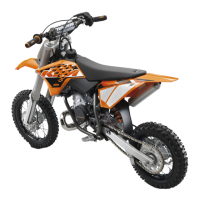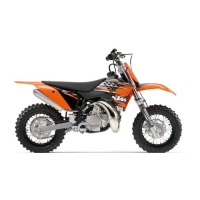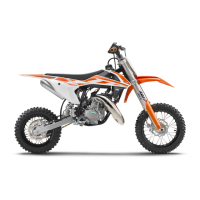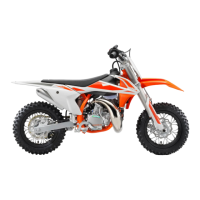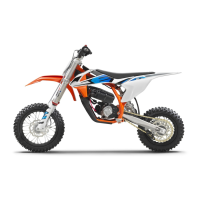10 TUNING THE CHASSIS 23
10.1 Adjusting the rebound damping of the shock absorber
Caution
Danger of accidents Disassembly of pressurized parts can lead to injury.
– The shock absorber is filled with high density nitrogen. Adhere to the description provided. (Your authorized KTM workshop
will be glad to help.)
601591-10
– Turn adjusting screw 1 clockwise up to the last perceptible click.
– Turn back counterclockwise by the number of clicks corresponding to the shock
absorber type.
Guideline
Rebound damping (50 SX)
Standard 10 clicks
Rebound damping (50 SX Mini)
Standard 12 clicks
Info
Turn clockwise to increase damping; turn counterclockwise to reduce damp-
ing.
10.2 Measuring rear wheel sag unloaded
Preparatory work
– Raise the motorcycle with a lift stand. ( p. 27)
400988-10
Main work
– Measure the distance – as vertical as possible – between the rear axle and a fixed
point, for example, a mark on the side cover.
– Make a note of the value as measurement A.
Finishing work
– Remove the motorcycle from the lift stand. ( p. 27)
10.3 Checking the static sag of the shock absorber
400989-10
– Measure distance A of rear wheel unloaded. ( p. 23)
– Hold the motorcycle in a vertical position with the assistance of another person.
– Measure the distance between the rear axle and the fixed point again.
– Make a note of the value as measurement B.
Info
The static sag is the difference between measurements A and B.
– Check the static sag.
Static sag (50 SX) 20 mm (0.79 in)
Static sag (50 SX Mini) 15 mm (0.59 in)
» If the static sag is less or more than the specified value:
–
Adjust the spring preload of the shock absorber. x ( p. 24)

